Home » Geologic Hazards » Largest Hurricanes
What Was the Largest Hurricane to Hit the United States?
| Damage from the Great Galveston Hurricane |
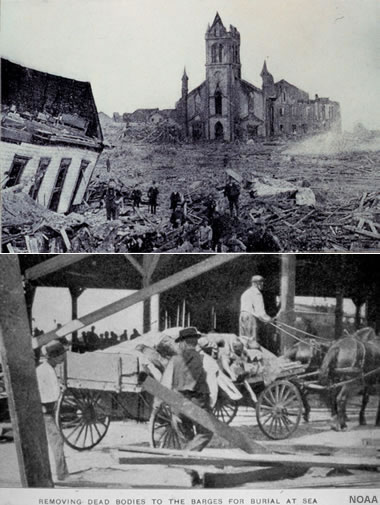
Damage from the Galveston Hurricane of 1900 was caused by the hurricane itself and its resulting storm surge. This was the greatest natural disaster, in terms of loss of life, in U.S. history. So many people were killed that horse carts were used to transport bodies through the streets of Galveston. Many bodies were placed on barges and buried at sea. Others were burned in huge funeral pyres. So many people were killed, and the tasks of handling the dead were so great, that an accurate count of fatalities was not possible. Photos and captions from NOAA.
Definition of "Largest Hurricane"
Wind speed, cost of damage, deaths, intensity, and width are a few ways to define the "largest hurricane". If using wind speed, intensity, or width as the definition, it is necessary to explain whether the measurement was recorded at landfall or was it the highest measurement recorded in the hurricane's life cycle.
Deadliest Hurricanes in U.S. History | |||
| Hurricane | Year | Category | Deaths |
| Great Galveston Hurricane | 1900 | 4 | 8000-12000 |
| Okeechobee Hurricane | 1928 | 4 | 2500-3000 |
| Cheniere Caminada | 1893 | 4 | 2000 |
| Hurricane Katrina | 2005 | 3 | 1200 |
| Sea Islands Hurricane | 1893 | 3 | 1000-2000 |
| Data from NOAA. [1] | |||
| Deadliest Hurricanes in United States History |
The largest loss of life from a hurricane is often caused by storm surge and flooding rather than the speed of the winds. So, do not underestimate a lower category hurricane! None of the top five deadliest hurricanes in United States history were a Category 5 hurricane at landfall. A weak hurricane that makes a direct hit on a major city, or one that moves slowly dropping lots of flood waters can cause more fatalities than storms of higher category.
Deadliest Hurricane to Hit the United States
The Great Galveston Hurricane of 1900 was the deadliest hurricane to ever hit the United States. Estimates of the number of lives lost range between 8,000 and 12,000 people. The number of people killed and the number of people involved in the recovery efforts were so large that an accurate count of fatalities was impossible to obtain.
The storm reached the Texas coast south of Galveston on September 8, 1900 as a Category 4 hurricane with a storm surge of 8 to 15 feet. The lack of warning and the high storm surge caused this storm to have the highest death toll of any United States hurricane.
Today we are fortunate to have weather satellites and aircraft monitoring the Atlantic Ocean and the Gulf of Mexico. These usually give us at least a few days of warning in advance of an approaching tropical storm or hurricane. These warnings were not available in 1900. As a result, people did not have time to prepare for the storm, and the importance of evacuation was not realized.
Second-Deadliest Hurricane to Hit the United States
The 1928 Okeechobee Hurricane, also known as the San Felipe Segundo hurricane, claimed 2,500 to 3,000 lives in central Florida. It was the second-deadliest hurricane in United States history.
The hurricane made landfall on the Florida coast as a Category 4 storm and quickly moved inland with strong winds. When the winds encountered Lake Okeechobee, they began blowing the surface water of the lake westward. As that surface water was pushed westward, sustained winds pushed even more of the water westward. Soon much of the water from the eastern half of the lake had been pushed into a six-to-ten-foot-high storm surge that piled up against the western side of the lake.
Much of the surge's water spilled into Okeechobee City on the northwest side of the lake and into Belle Glade on the southwest side of the lake. Several feet of water flooded the land around Okeechobee City and Belle Glade. Homes, businesses, roads and schools were flooded and lashed by waves driven by hurricane-force winds. Hundreds of square miles were flooded by the surge and over 1,000 people were drowned.
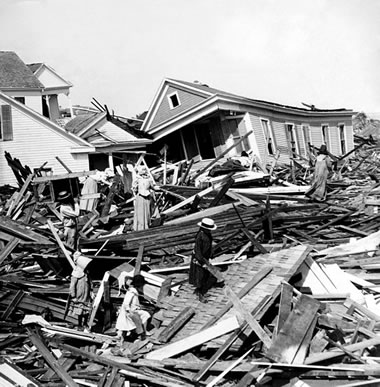
Storm Surge Debris: People searching through storm surge debris from the Great Galveston Hurricane of 1900. The boards in the image were mostly pieces of siding, ripped from homes that were destroyed by the surge. Image by the Keystone View Company, now in the public domain.
Third-Deadliest Hurricane to Hit the United States
The Cheniere Caminada Hurricane of 1893 (also known as "The Great October Storm") claimed an estimated 2,000 lives when it struck Cheniere Caminada island, Louisiana. It was a Category 4 hurricane with winds estimated to be blowing at 135 miles per hour when it made landfall near Cheniere Caminada. Most of the fatalities were caused by a storm surge up to 16 feet high that drowned nearly half the population of Cheniere Caminada.
| Costliest Hurricanes in United States History |
It is a common misconception that a lower category hurricane is less of a threat than a higher category hurricane. For example, Hurricane Katrina was the costliest hurricane in United States history, and it was only a Category 3 hurricane when it made landfall. Hurricane Katrina moved slowly, pushed storm surges onto the land, and dropped heavy rain on New Orleans - a city that was already below sea level.
Hurricane Sandy, also known as "Superstorm Sandy," was downgraded to a tropical storm shortly before making landfall, but it still caused over $85 billion in damage and is currently the fourth-costliest storm to hit the United States. Much of that damage was caused when the storm hit the highly populated areas of New York and New Jersey. The storm surge that hit New York City flooded streets, subways, tunnels, and damaged utility services. 286 people lost their lives, and a trail of destruction was left in the United States, Bermuda, and the Caribbean islands.
| Satellite Image of Hurricane Katrina |
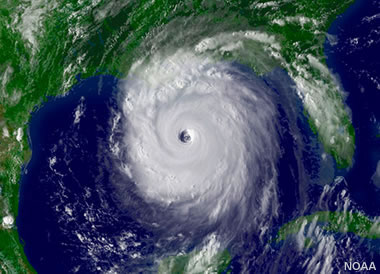
Satellite image of Hurricane Katrina showing its massive width while in the Gulf of Mexico before hitting New Orleans, Louisiana, and Mississippi. Image by NOAA.
Costliest Hurricane to Hit the United States
Hurricane Katrina in 2005 was easily the costliest hurricane in United States history with property damages over $125 billion, or $193.8 billion when adjusted to 2023 dollars. Storm surge along the Mississippi coast completely destroyed many structures, with damage extending several miles inland.
Katrina's storm surge topped and breached levees in the New Orleans metropolitan area, resulting in the inundation of much of the city and its eastern suburbs. Wind damage from Katrina extended well inland into northern Mississippi and Alabama as well as in Miami-Dade and Broward counties of Florida.
Costliest Hurricanes in U.S. History | |||
| Hurricane | Year | Category At Landfall | Cost |
| Hurricane Katrina | 2005 | 3 | $193.8 Billion |
| Hurricane Harvey | 2017 | 4 | $153.8 Billion |
| Hurricane Ian | 2022 | 4 | $115.2 Billion |
| Hurricane Sandy | 2012 | * | $85.2 Billion |
| Hurricane Ida | 2021 | 4 | $81.7 Billion |
| * Hurricane Sandy had degraded to a tropical storm shortly before making landfall. Damage costs adjusted for inflation to 2023 dollars. Data from NOAA. [2] | |||
Second-Costliest Hurricane to Hit the United States
In 2017, Hurricane Harvey first made landfall on San Jose Island, Texas as a Category 4 hurricane with winds of 130 miles per hour. Harvey then hit mainland Texas a few hours later. An estimated half a million vehicles and three hundred thousand structures were damaged or destroyed in Texas.
The hurricane then stalled over Texas as a tropical storm, and in the Houston metropolitan area many locations recorded over 30 inches of rain within a three-day period. Harvey then went back into the Gulf of Mexico, hit Louisiana, and continued in a northeastward track as a tropical depression, causing more flooding along the way. All of the flooding, building damage, vehicle damage, infrastructure damage, and other associated damages are estimated to have been $125 billion (or $153.8 billion in 2023 dollars).
Third-Costliest Hurricane to Hit the United States
Hurricane Ian caused $115.2 billion in damage and killed over 150 people in 2022. The storm first made landfall near La Coloma, Cuba, and then it proceeded northward over the Dry Tortugas islands before making landfall in Cayo Costa, Florida, and then Punta Gorda, Florida. Hurricane Ian crossed the Florida peninsula to the Atlantic Ocean at Cape Canaveral, then it re-strengthened and made landfall again near Georgetown, South Carolina. The storm finally dissipated as it moved inland over North Carolina.
In the state of Florida, many areas were severely damaged by the catastrophic storm surge, historic flooding, and high winds. Thousands of structures were completely destroyed, and thousands more sustained major damage. Millions of people were without power for days. At the time of this writing (August 2023), Hurricane Ian was the costliest hurricane in Florida's history. [4]
| Satellite Image of Hurricane Camille |
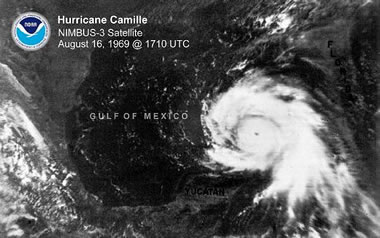
This is a black-and-white satellite image of Hurricane Camille from 1969 while in the Gulf of Mexico, before it hit Mississippi and Louisiana. Image by NOAA.
Hurricanes with the Highest Wind Speed at Landfall | |||
| Hurricane | Year | Category | Wind Speed (mph) |
| Hurricane Camille | 1969 | 5 | 190 |
| Hurricane Andrew | 1992 | 5 | 167 |
| "Labor Day" Hurricane | 1935 | 5 | 161 |
| Indianola Hurricane | 1886 | 4 | 155 |
| Hurricane Charley | 2004 | 4 | 150 |
| Hurricane Ian | 2022 | 4 | 150 |
| Hurricane Ida | 2021 | 4 | 150 |
| Hurricane Laura | 2020 | 4 | 150 |
| Data from NOAA [1], [4], and the National Weather Service [5], [6]. | |||
| Highest Wind Speed at Landfall in US History |
|
Meteorologists use sustained wind speed to determine what category a hurricane is. To the left is a table showing what wind speeds define the different storm categories. The wind speed must last for over one minute to be considered a sustained wind, while a gust is the highest wind speed for a three-second period within the one-minute sustained reading.
Most of the highest wind speeds at landfall are estimated because of damage to (or lack of) wind-recording instruments.
Hurricane with the Highest Wind Speed at Landfall in United States History
Hurricane Camille of 1969 had the highest wind speed at landfall, at an estimated 190 miles per hour when it struck the Mississippi coast. This wind speed at landfall is the highest ever recorded worldwide. Actual maximum sustained winds will never be known because the hurricane destroyed every wind-recording instrument in the landfall area. Columbia, Mississippi, located 75 miles inland, reported 120 mph sustained winds.
Hurricane with the Second-Highest Wind Speed at Landfall in United States History
Hurricane Andrew holds the title of the hurricane with the second-highest recorded wind speeds at landfall, with winds estimated at 167 miles per hour as it crossed south Florida. Many of the instruments for measuring wind speeds were destroyed by the hurricane, which leaves the actual sustained wind speeds unknown.
Hurricane with the Third-Highest Wind Speed at Landfall in United States History
The 1935 Labor Day Hurricane had estimated winds of 161 miles per hour, the third-highest wind speed at landfall of any hurricane to strike the United States. The wind speed is estimated, using hurricanes with similar pressure readings at landfall, because of the lack of wind instruments at the time.
| References |
|
[1] The Deadliest, Costliest, and Most Intense United States Tropical Cyclones From 1851 to 2010 (and Other Frequently Requested Hurricane Facts): Eric S. Blake, Christopher W. Landsea, and Ethan J. Gibney; NOAA, August 2011, PDF document on the nhc.noaa.gov website, pages 7 - 9. [2] Costliest U.S. Tropical Cyclones: NOAA’s National Centers for Environmental Information (NCEI) in consultation with the National Hurricane Center (NHC), July 11, 2023. [3] Project Report: Ascertainment of the Estimated Excess Mortality from Hurricane Maria in Puerto Rico: The George Washington University Milken Institute School of Public Health, in collaboration with the University of Puerto Rico Graduate School of Public Health, 2018. [4] Hurricane Ian: National Hurricane Center Tropical Cyclone Report AL092022, by Lisa Bucci, Laura Alaka, Andrew Hagen, Sandy Delgado, and Jack Beven, April 2, 2022. [5] Hurricane Ida: Report from the National Weather Service, Weather Forecast Office in Lake Charles, Louisiana. [6] Hurricane Laura: Report from the National Weather Service, Weather Forecast Office in Lake Charles, Louisiana. |
| Largest Hurricanes to Hit Inhabited U.S. Territories |
Only the Inhabited Territories of Puerto Rico, U.S. Virgin Islands, American Samoa, Guam, and the Northern Mariana Islands were used for these statistics. Other United States territories and disputed territories are uninhabited and without advanced hurricane monitoring.
The U.S. territories of American Samoa, Guam, and the Northern Mariana Islands are located in the western Pacific Ocean, where these types of storms are called typhoons rather than hurricanes.
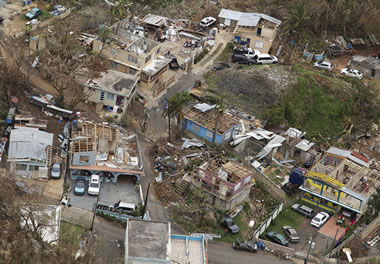
Hurricane Maria: Photograph of damage done by Hurricane Maria in Puerto Rico. Photograph by Yuisa Rios of FEMA.
Deadliest and Costliest to Hit an Inhabited U.S. Territory
Hurricane Maria made landfall near Yabucoa, Puerto Rico as a Category 4 storm on September 20th, 2017. The initial fatality number of 64 was widely disputed and considered far too low. The George Washington University, with the help of other educational institutions and Puerto Rican authorities, analyzed data and other factors to get to the current and accepted fatality count of 2,975 [3]. This places Hurricane Maria as the deadliest hurricane to make landfall on an inhabited U.S. territory. It would also place it as the second-deadliest hurricane to strike the United States or its territories.
Along with being the deadliest hurricane, Hurricane Maria was also the costliest hurricane to hit an inhabited U.S. territory. Hurricane Maria tracked in a northwest direction across the main island of Puerto Rico. There was not a single municipality on the island that was not affected by this hurricane. Between infrastructure, agricultural, property and other damage, the total estimated cost of this hurricane in 2023 dollars was $110.7 billion [2]. The destruction was so widespread that shortly after the hurricane went through, all of Puerto Rico was declared a Federal Disaster Zone.
Hurricane with the Highest Wind Speed to Hit an Inhabited U.S. Territory
The Okeechobee Hurricane, also known as the San Felipe Segundo Hurricane, had the highest wind speed at landfall of any hurricane to impact an inhabited U.S. territory. It had wind speeds of 160 miles per hour when it made landfall in Puerto Rico in 1928. The Okeechobee Hurricane is the only hurricane to strike Puerto Rico as a Category 5 storm.
| More Earth Extremes |
 |
The Tallest Waterfall in the U.S. |
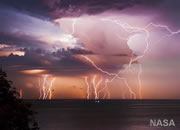 |
World Record Lightning |
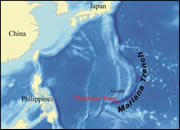 |
Deepest Point in the Ocean |
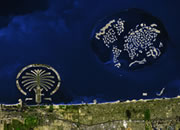 |
Largest Man-Made Islands |
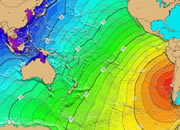 |
Largest Earthquake |
 |
Tallest Mountain |
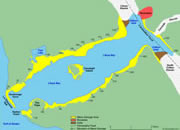 |
Largest Tsunami |
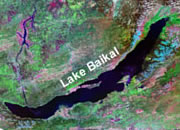 |
Deepest Lake in the World |

Find Other Topics on Geology.com:

|

| ||

|

| ||

|

| ||

|

|
